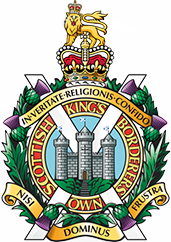Captain Hamish Samson MC: The Borderer who came back from the dead

For almost three months after Capt Hamish Weir Samson MC led Borderers “over the top” in the Battle of Arras, in northern France, he was presumed dead. His family were warned to expect the worst and they soon took delivery of official confirmation of his death from the War Office. But Capt Samson’s father, John, never gave up hope that his son had survived the bloody conflict. And almost 12 weeks after his apparent “death”, the family received a letter from their son confirming that he was very much alive. The remarkable document reveals that he had been shot in the arm and the side and was being treated in a German prisoner of war hospital.
Now, exactly 100 years since that battle, the legacy of Capt Samson and his father’s unfailing hope stands in a church in Dumfriesshire. The chancel at St Bride’s Church in Sanquhar celebrates the astonishing survival of the soldier who fought in a battle which claimed 18,000 Scottish lives.
Capt Samson of the 6th Battalion led C company “over the top” on the morning of 3 May, 1917. It was not a success and he failed to return to the British lines with the remnants of the 6th Battalion, many of whom fell that day. An eyewitness reported seeing the Samson fall to the ground beside Oppy Wood not long after the beginning of the attack. His body was never recovered and his family were warned that he was likely to have died.
However, his father John Samson, who was managing partner of Sanquhar and Kirkconnel Collieries, never gave up hope that his son was alive. The family repeatedly pressed the War Office and Spanish Consul, which represented British interests in the war, for news. Letters and telegrams were exchanged for three agonising months
One by Major A Innes Browne, Second in Command of the 6th Battalion, stated: “There is just a remote chance that your son might be a prisoner and wounded, but so remote we do not believe it is so”.
The family were informed on 22 July, 1917 that Capt Samson had been killed. But a few weeks later they finally received the news they had all been praying for. Capt Samson, who was known as “Sammy”, had been captured and was being held in a PoW hospital in south-west Germany. The family received a letter from the officer himself, dated 27 July, 1917, in which he informed them that he was being treated well in the circumstances. Samson spent the rest of the war in a variety of PoW camps. He eventually returned to Scotland in December 1918 and took up residence at the family home, Glaisnock House in Cumnock, East Ayrshire. To celebrate his son’s survival, John Samson made a large donation to the church in Sanquhar, to extend the building.

Duncan Close, session clerk of St Bride’s Church, added: “The link between our chancel and the dreadful struggles of WW1 has never been stronger. We are fortunate that we know so much of Capt Samson’s involvement during the war, and his survival and return home indicates a very brave and resolute soldier. From the terrible scenes from the trenches and Arras, the new chancel took shape. Today, 100 years after Capt Samson’s miraculous escape from death, we have a truly magnificent memorial to one soldier’s survival, and the family faith that refused to believe he had been lost”.
It is understood that Capt Samson worked for a spell in his father’s mining company before training as a stockbroker.
He was married and had two children.
During the World War Two he served with the Home Guard in Inverness.
He moved south of the border in later life and died in Hove, Sussex, in 1971 at the age of 76.
Capt Samson also served with the Cameronians (Scottish Rifles), astute Borderers will have noted from the photograph.
“Always a Borderer”
